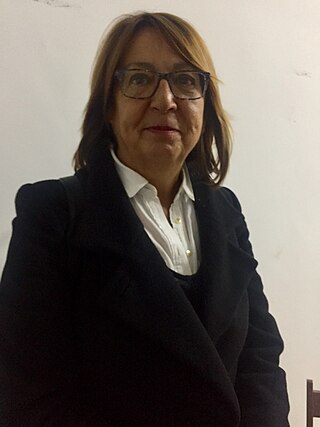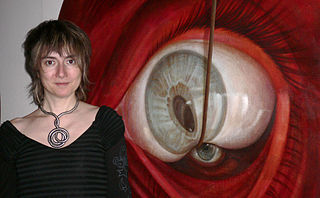
José Manuel Fors is a contemporary Cuban artist born in Havana in 1956. His work is principally based on installations and supported by photography. His first artistic forays, during the early eighties, were part of what has been coined "The Renaissance of Cuban Art". His artwork has been shown in renowned museums and galleries in the United States, Europe and Cuba.

Clara Ledesma Terrazas was an artist from the Dominican Republic.

Marisa González is a Spanish multimedia artist. She is considered a pioneer in Spain for the use of the new technologies in contemporary art. She works in distinct disciplines like photography, installations, video-art or net-art. She has been Vice President of the association Mujeres en las Artes Visuales MAV, from 2010 until 2016.

Rocio de la Villa is a Spanish university professor, art historian, curator, researcher and art critic. She has edited and collaborated in the edition of distinct catalogues and publications related with the art and the position of the woman in the artistic world. In 2014 she was rewarded with the Prize MAV in the modality of Criticism of art. She also goes by the names Rocio de la Villa Ardura and Rocio Villa-Ardura.

Celia Amorós Puente is a Spanish philosopher, essayist and supporter of feminist theory. She is a key figure in the so-called equality feminism and focused an important part of her research in the building of relations between Enlightenment and feminism. Her book Hacia una crítica de la razón patriarcal constitutes a new outlook on the gender perspective of philosophy, revealing the biases of androcentrism and claims a critical review on behalf of women.

Marian Lopez Fernandez-Cao is a Spanish university professor, curator and researcher, specializing in art, feminism, art therapy and social inclusion. Since 1992 she has been a professor in the Universidad Complutense of Madrid, and is expert on the artist Sonia Delaunay.
María Dávila Guerra is a contemporary Spanish painter. She was born in Málaga, and lives and works in Granada.

Marina Núñez is a Spanish artist, and a professor at the University of Vigo. Her work is included in the collections of Museo Nacional Centro de Arte Reina Sofía in Madrid, Artium in Vitoria, MUSAC in Leon, Patio Herreriano in Valladolid, TEA in Tenerife, Fundación La Caixa, Fundación Botín, Corcoran Gallery of Art in Washington, DC, National Museum of Women in the Arts in Washington DC, Mint Museum of Art in Charlotte, North Carolina, Katzen Arts Center, American University Museum, in Washington DC, Fonds régional d'art contemporain in Corsica, France.
Cecilia Paredes is a Peruvian-born multimedia artist residing in Philadelphia. Her primary themes include the power of nature, femininity, and migration, which have been subjects of many of her shows. She frequently utilizes natural elements, often recycled waste materials and primarily organic ones, in her installations. One of her best-known works is "Paisajes" in which she camouflages herself and uses her own figure as a canvas for body painting.
Teresa Serrano (1936) is a Mexican painter, sculptor, and filmmaker. She gained recognition through her work in filmmaking in the mid to late 1990s. Her main focus has been "to make forceful commentaries on power relationships, sexism, and violence against women".

Concha Jerez is a Spanish multidisciplinary artist known as a pioneer in conceptual art. One of the central axes of her work is the critical analysis of the media.

Carmen Calvo Sáenz de Tejada is a Spanish conceptual artist, noted for her contribution to the contemporary art of the Valencian Community.

Andrea Graciela Giunta is an Argentine art historian, professor, researcher, and curator.
Feminist genealogies in the spanish art 1960-2010, in Spanish, Genealogías feministas en el arte español: 1960-2010 was an exhibition held from 24 June 2012 to 24 February 2013 at the Contemporary Art Museum of Castilla y León, in León, Spain. It was developed by Patricia Mayayo and Juan Vicente Aliaga, who are curators and academic university teachers and researchers, and showcased over 150 works by 80 artists. The exhibition originated from extended research, ended in a publication with the same title, in which the leading specialists in the field collaborated, such as Rocio de la Villa, Isabel Tejeda, Beatriz Preciado, Noemí de Haro, among others.

Vanesa Cejudo Mejías is a Spanish sociologist, and a researcher and critic of contemporary visual culture. She advocates for the use of art in education, having worked both as an artist and as a professor at the Pontifical University of Salamanca. She also promotes the work of women in the Spanish art community as a director of the Asociación de Mujeres en las Artes Visuales (MAV).

María Ortega Gálvez is a Spanish artist specializing in painting, engraving, photography and textiles. She is director of the international association World Textile Art (WTA) and director of WTA's VIII International Biennial of Contemporary Textile Art, held in Madrid, Spain in 2019.
Patricia Torres, known as Patricia Torres is a Mexican artist. She uses different forms of visual expression, such as painting, drawing, printmaking, multimedia pieces and video. The themes in her work are related to the female body, its acceptance and the interventions that are made to normalize it, to ensure that it is accepted and valued in society.

Zenobia Galar is a Dominican painter.

Nekane Aramburu Gil is a Spanish art historian with an extensive international career, who has worked as a cultural manager, museologist and curator since the 1990s. She was selected by competition as director of the Es Baluard museum in February 2013, following the recommendations of the Code of Good Practice in Museums and Art Centers in Spain, a position she held for six years. Since that date Es Baluard has been an organic and dynamic museum; its collections, activities and educational models were rearranged giving rise to an active cultural complex.

Patricia Mayayo Bost is a Spanish art historian, professor, and researcher. Her areas of research and study include the historiography of feminist and queer art, the history of women artists, and contemporary artistic practices.














